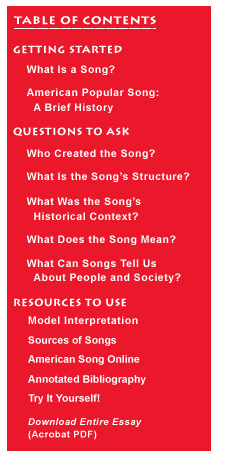talking history | syllabi | students | teachers | puzzle | about us

|
 |
| If the musical item at hand is a piece of printed music, then by law the names of the lyricist and composer will be printed at the top of the music. If it is an LP or CD, then the names will be printed on the label and/or the cover. Perhaps the same person composed both words and music, a practice that became much more common in the twentieth century. Even if we are dealing with a “folk song,” it is reasonable to assume that someone must have been the first to sing those words, to sing that tune, and to put words and tune together. In this case, however, the song’s creators are typically unknown to many people who sing the song, although research will sometimes reveal the identity of an author and lyricist in the not-too-distant past. Most people in the United States know “Auld Lang Syne” (1788, 1799) and “Happy Birthday” (1893). But how many know that Robert Burns wrote the words to the former or that Mildred and Patty Hill composed the tune of the latter and published it in 1893 in a kindergarten songbook with the lyric, “Good morning to all”? To assign credit to a lyricist and a composer, however, does not always tell us who created the song we see, much less the song we hear. Who created the harmonies? Who worked out the accompaniment on piano or guitar? If we’re listening to a recording, who produced it? If we’re watching a video, who created the choreography and the visual sequences? In this sense, most songs have many creators, particularly when we talk about songs as they are performed and recorded. Many of these creators can be identified, their roles explored. We often want to date the creation of a song—for example, to understand the circumstances of its creation or to understand its place in the creator’s biography. Printed music almost always transmits a date of publication; by the 1970s recordings often included a date on the label. For earlier recordings, try to find the date in a discography like those published by Brian Rust and his collaborators, listed in the annotated bibliography. But in many cases a song was not published or recorded until several years after its creation, and here the search for an earliest date becomes a matter of research on biographies and performance history. If there are several versions of the song, then we may want to ask which versions are earlier, which are later, and what is the relation of the versions to one another. Many songs were created for a specific purpose, often having to do with publication or performance and profit. To pick a few examples from songs mentioned above: Henry Clay Work wrote “Come Home Father” (1864) for publication; Irving Berlin composed “God Bless America” in 1918 as a response to the First World War. But songs often transcend the purposes for which they were written. “Come Home Father” gained tremendously in popularity when it was interpolated into Timothy Shay Arthur’s Ten Nights in a Bar Room, a play promoting the temperance movement. Berlin reworked “God Bless America” and published it in 1939, as the Second World War approached in Europe. Following the terrorist attacks of September 11, 2001, “God Bless America” became a sign-off tune for TV stations, and its title became a bumper sticker. Sometimes (but not very often) the creators of a song say why they originally composed it. Merle Haggard stated in an interview that “Okie from Muskogee” (1969) “started as a joke” when he and his band mates saw a road sign for Muskogee, Oklahoma, and speculated that no one there smoked marijuana. That did not stop people from taking Haggard’s song literally and turning it into an anthem of rural conservatism in the 1970s. The creator’s statement of intent may help answer the question of why was the song first created, but it does not answer questions about why the song appealed to people and what it meant to them.
The most popular form of music in the United States during most of the nineteenth century was blackface minstrelsy. Since its beginnings in the 1830s, most minstrel performers were white men who pretended to be African-American singers and dancers. Minstrelsy promoted images of African Americans that were based more on the fantasies of the white performers than on the realities of black culture and experiences. Minstrel shows presented derogatory, stereotypical images of African Americans as unintelligent, ugly, and often violent. By the late nineteenth century, many African-American performers also participated in the blackface minstrel industry, since the only opportunities available to them within national theater circuits involved donning burnt cork and performing racist caricatures. Some, but not all, African-American performers and songwriters attempted to challenge the racist caricatures of blackface from the minstrel stage. Many minstrel songs were published and sold as sheet music. With close examination, this printed music can give us a number of clues about the stereotypes prevalent in minstrelsy, the history of the music publishing industry, and the politics of the era. Read the following songs carefully; can you tell if the song was written by an African-American or a white composer?
|
|

|
|

